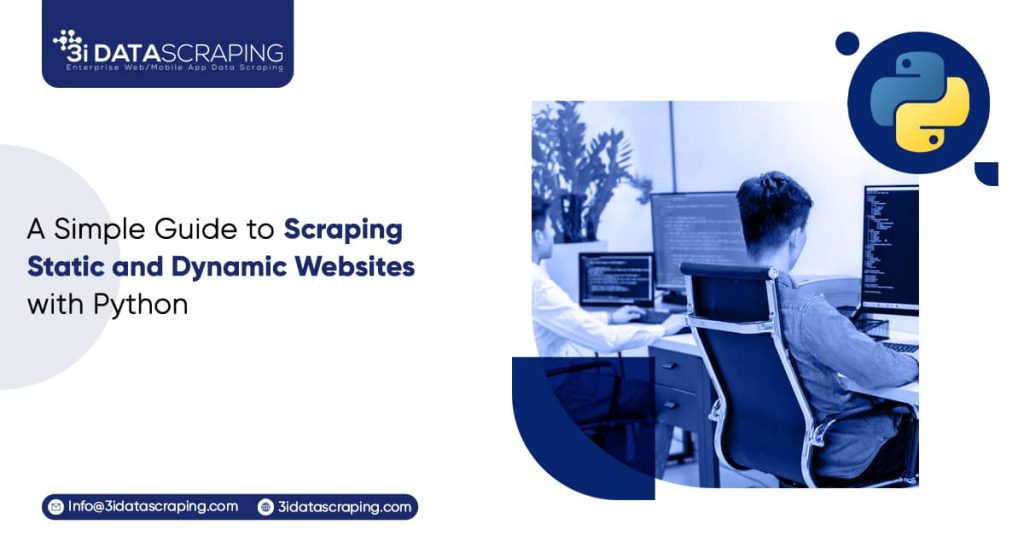A Simple Guide to Scraping Static and Dynamic Websites with Python
Dive into the world of static and dynamic website scraping with Python and learn the procedure of data extraction from such websites.
- February 20, 2023
Our achievements in the field of business digital transformation.









Imagine having to pull out a large amount of data from a website. Also, the need of the hour is to extract all the essentials at lightning speed. Well, in situations like this, web scraping comes to the rescue. From making the task easier to ensure the quality of the data collected, web data extraction has come a long way.
From static to dynamic, each website gets scraped by web scraping bots and presented in a structured format today.
However, how does a bot scrape a static website? What goes into dynamic website scraping with Python? What benefits do the different types of websites possess?
Well, let us delve deeper to know more!
Static and Dynamic Website - An Introduction
A website is a web page collection, including text, images, and videos. This multimedia content gets accessed by the URL, visible on the browser’s address bar. There exist two types of websites- Static and Dynamic.
Static Websites
In this, web pages get returned by the server, which is a prebuilt source code file. These get built using simple languages such as HTML, CSS, or JavaScript. In a static website, the server has no content processing (according to the user).
Here, web pages get returned by the server without any changes. All this makes static websites faster. There does not exist any interaction with databases. Also, they cost less since the host does not need to support server-side processing with the help of different languages.
Dynamic Websites
Here, web pages get returned by the server that gets processed during runtime. These are not prebuilt web pages. In fact, they get built during runtime per the user’s demand with the help of PHP, Node.js, ASP.NET, etc. It is the reason they are slower than static websites. However, updates and interaction with databases are possible.
Dynamic Websites are more popular than Static ones as they involve easy updates.
Benefits of Static and Dynamic Websites
There exist several benefits of both Static and Dynamic websites. Well, let us look at each individually.
Static Websites – Benefits
Some key benefits of Static websites are:
Faster Creation
Static websites are less complex by nature. Also, they do not need to get linked to databases with organized material. As a result, they may get created and published more quickly.
Static pages can often be simpler to design. Hence, they can get deployed more quickly.
Faster and Better Page Load Time
The structure of a static website prioritizes load time, thus improving browsing efficiency. These websites typically use fewer server resources and load faster. It happens because they do not have to pass through a database infrastructure or client-server.
Dynamic Websites- Benefits
Some key benefits of Dynamic websites are:
Easy to Update
In dynamic websites, with the change in a page’s content, the content of other pages changes, too, without altering the look. As a result, dynamic websites get updated quickly and easily.
Scalability also becomes possible with dynamic pages because they allow quick and easy handling of thousands of pages. A dynamic website has the flexibility to develop as and when needed.
Better Efficiency
Dynamic pages possess efficiency and are interactive by nature. As such, they deliver a higher standard of quality and efficient services to the end users.
Difference between Scraping Static and Dynamic Websites

Static websites are generally easier to scrape. It is because the data gets fixed on the HTML when the page loads. It means they help get the HTML using packages like requests easily. It then parses it to get the needed data.
On the contrary, dynamic websites get very hard to scrape. It happens because of its dynamic part, which involves JavaScript. When a website gets loaded, it loads the HTML first, and then JavaScript populates the HTML with the required data, thus creating difficulties.
Ways to Scrape Static Websites With Python
For Scraping Static Websites With Python, Follow These Simple Steps:
- Decide what data needs to get extracted. Open the terminal and run the command that creates a new folder on the desktop along with the extension (.py).
- Start visual studio code by running the command- $ code.
- At this point, open the only available empty file in the folder called “scrapper.py” and import the entire library.
- Import the pandas library that helps convert the data to a data frame. It will later get exported into a CSV file. It will help in sending an HTTP request and getting the website code.
- The library will take the HTTP request and convert it into a text file, where required data can get searched.
- Now, create an empty array under a variable. After a GET request to the WSOP site, save the request on the variable page. Here, use the .text method to turn these requests into text.
- Use the BeautifulSoup method to parse the data. Save it under the variable soup. Use the find method to find the required element.
- In this step, look for all the elements that are <a> tags and save them. Perform a loop to iterate through the array of <a> tags and get the link using the .get method. Loop through every single URL and extract the data.
- Create empty arrays where the final data will get saved. Send a GET request to the URLs, and turn the request into a text file. Use the BeautifulSoup method to parse the text file.
- Select the first and only <img> tag and use the method .get to obtain the src attribute of the given tag where the URL of the image is present.
- After getting the required data, form a data frame (CSV file). Create an object with a key and value pair. The key will be the header of the data frame.
- For importing this CSV file to a Rails database, give the key name the same as the SQL columns. Now, use the DataFrame method to convert the data into a data frame.
- Export the data frame to a CSV file using the method .to_csv(“name.csv”). And the static website scraping is done.
Scraping Dynamic Website with Python

For Scraping Dynamic Websites With Python, Follow These Simple Steps:
- Use a headless web browser to scrape a dynamic website. The first step begins with the importing of required libraries. As such, use a mix of BeautifulSoup and Selenium to extract the data.
- To scrape any data, begin by knowing the location of the data. The easiest way to locate an element is to open the Chrome dev tools and inspect the required data.
- The next step is extracting the resultant page links. Now, scrape a website and collect the URLs of different pages of search results. Here, a while loop gets used to iterate through the search result pages. The loop starts by navigating to the current URL using ‘driver. get()’ method. It then gets the page’s HTML source code using ‘driver.page_source’ and parses it. Store each of the page_url in the list page_lst_link.
- Now extract product links from the resultant pages. Here, the ‘page_lst_link’ variable must contain a list of page links. The code will iterate through each page link and use the web driver to navigate to that page. Use BeautifulSoup to parse the HTML of the page. Now, extract all product links. Store each of the product links in the list product_links.
- In this step, create a data frame to store the extracted data. Create data frame per requirement. Now, scrape the relevant information.
- Store the requests from the URL in page_content using the selenium web driver. Create the product_soup variable by parsing page_content with Beautifulsoup. Also, create the dom using ElementTree. This method returns the dom, used to extract specific elements from the page using methods like .xpath() and .cssselect().
- After extracting the relevant information, create a CSV file. And the Dynamic website scraping is done.
Final Thoughts
Today, Python has become a powerful tool that provides an array of libraries and frameworks for handling different data types. Several industries have achieved tremendous growth and success with the help of web scraping and Python. Whether static or dynamic websites, web data extraction has made information collection faster, aiding enterprises immensely.














What Will We Do Next?
- Our representative will contact you within 24 hours.
- We will collect all the necessary requirements from you.
- The team of analysts and developers will prepare estimation.
- We keep confidentiality with all our clients by signing NDA.





